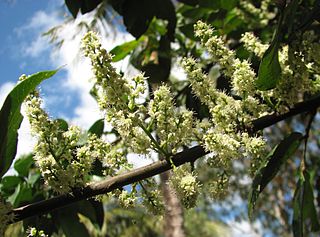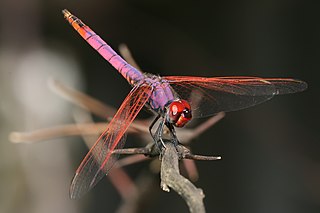
Guioa is a genus of about 78 rainforest tree species known to science, which constitute part of the plant family Sapindaceae. They have a wide distribution, ranging from throughout Malesia, in Burma, Cambodia, Vietnam, Thailand, Malay Peninsula, Borneo, Sumatra, Philippines, Java, Flores, Timor, Sulawesi, Moluccas, New Guinea, further southwards through the east coast of Queensland and New South Wales, Australia and further eastwards to the Pacific Islands, including Tonga, New Caledonia, Fiji and Samoa.
This article is a list of biological species, subspecies, and evolutionary significant units that are known to have become extinct during the Holocene, the current geologic epoch, ordered by their known or approximate date of disappearance from oldest to most recent.

Trithemis is a genus of dragonflies in the family Libellulidae. They are commonly known as dropwings. There are over 40 species, mainly from Africa; two are endemic to Madagascar, and five can be found in Asia. They are found in a wide variety of habitats; some species being adapted to permanent streams in forests, and others being capable of breeding in temporary pools in deserts.

Kirkia is a genus of plant in family Kirkiaceae. It was previously placed in family Simaroubaceae, but was transferred into Kirkiaceae, together with Pleiokirkia, because these genera produce neither quassinoids nor limonoids.
Dioscorea ovinala is a species of yam in the family Dioscoreaceae. It is endemic to Madagascar and grows mostly in dry deciduous forests.

Dioscorea quartiniana is a climbing tuber geophyte in the family Dioscoreaceae. It is native to Benin, Botswana, Burundi, Chad, Congo, Côte d'Ivoire, Eritrea, Ethiopia, Gambia, Ghana, Kenya, Madagascar, Malawi, Mozambique, Namibia, Nigeria, Rwanda, Sierra Leone, South Africa, Sudan, Tanzania, Uganda, Zambia, and Zimbabwe. This species occurs in forests, grasslands, and rocky areas.
Dioscorea alatipes is a herbaceous vine in the genus Dioscorea. It is indigenous to the Morondava Prefecture in Madagascar and is listed as an vulnerable on the IUCN Red List in 2017, having previously been listed as endangered in 2001. It has been confused with another Dioscorea species, D. bako which is a food source of the indigenous people of the region. D. alatipes is found growing in forested areas on sandy soils or on limestone substrate. This species is managed for human consumption as part of the SuLaMa Project. According to the IUCN, the species is threatened by overharvesting of the tubers as well as by the expansion of farmland in the area.




